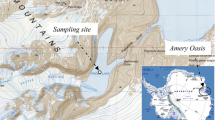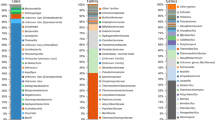Abstract
Denaturing gradient gel electrophoresis (DGGE) of PCR-amplified 16S rDNA fragments was used to explore the genetic diversity of hydrothermal vent microbial communities, specifically to determine the importance of sulfur-oxidizing bacteria therein. DGGE analysis of two different hydrothermal vent samples revealed one PCR band for one sample and three PCR bands for the other sample, which probably correspond to the dominant bacterial populations in these communities. Three of the four 16S rDNA fragments were sequenced. By comparison with 16S rRNA sequences of the Ribosomal Database Project, two of the DGGE-separated fragments were assigned to the genusThiomicrospira. To identify these ‘phylotypes’ in more detail, a phylogenetic framework was created by determining the nearly complete 16S rRNA gene sequence (approx. 1500 nucleotides) from three describedThiomicrospira species, viz.,Tms. crunogena, Tms. pelophila, Tms. denitrificans, and from a new isolate,Thiomicrospira sp. strain MA2-6. AllThiomicrospira species exceptTms. denitrificans formed a monophyletic group within the gamma subdivision of the Proteobacteria.Tms. denitrificans was assigned as a member of the epsilon subdivision and was distantly affiliated withThiovulum, another sulfur-oxidizing bacterium. Sequences of two dominant 16S rDNA fragments obtained by DGGE analysis fell into the gamma subdivisionThiomicrospira. The sequence of one fragment was in all comparable positions identical to the 16S rRNA sequence ofTms. crunogena. Identifying a dominant molecular isolate asTms. crunogena indicates that this species is a dominant community member of hydrothermal vent sites. Another ‘phylotype’ represented a newThiomicrospira species, phylogenetically in an intermediate position betweenTms. crunogena andTms. pelophila. The third ‘phylotype’ was identified as aDesulfovibrio, indicating that sulfate-reducing bacteria, as sources of sulfide, may complement sulfur- and sulfide-oxidizing bacteria ecologically in these sulfide-producing hydrothermal vents.
Similar content being viewed by others
Abbreviations
- PCR :
-
Polymerase chain reaction
- DGGE :
-
Denaturing gradient gel electrophoresis
References
Brosius J, Dull TJ, Sleeter DD, Noller HF (1981) Gene organisation and primary structure of a ribosomal RNA operon fromEscherichia coli. J Mol Biol 148:107–127
Cavanaugh CM, Gardiner SL, Jones ML, Jannasch HW, Waterbury JB (1981) Prokaryotic cells in the hydrothermal vent tube wormRiftia pachyptila Jones: possible chemoautotrophic symbionts. Science 213:340–342
Distel DL, Wood AP (1992) Characterization of the gill symbiont ofThyasira flexuosa (Thyasiridae: Bivalvia) by use of polymerase chain reaction and 16S rRNA sequence analysis. J Bacteriol 174:6317–6320
Distel DL, Felbeck H, Cavanaugh CM (1994) Evidence for phylogenetic congruence among sulfur-oxidizing chemoautotrophic bacterial endosymbionts and their bivalve hosts. J Mol Evol 38:533–542
Don RH, Cox PT, Wainwright B, Baker K, Mattick JS (1991) “Touchdown” PCR to circumvent spurious priming during gene amplification. Nucleic Acids Res 19:4008
Elsgaard L, Guezennec J, Benbouzid-Rollet N, Prieur D (1991) Fatty acid composition of sulfate-reducing bacteria isolated from deep-sea hydrothermal vents (13°N, East Pacific Rise). Kiel Meeresforsch Sonderh 8:182–187
Evers S, Weizenegger M, Ludwig W, Schink B, Schleifer KH (1993) The phylogenetic positions ofPelobacter acetylenicus andPelobacter propionicus. Syst Appl Microbiol 16:216–218
Felbeck H, Childress JJ, Somero GN (1981) Calvin-Benson cycle and sulphide oxidation enzymes in animals from sulphide-rich habitats. Nature 293:291–293
Felsenstein J (1989) Phylip—Phylogeny inference package. Cladistics 5:164–166
Fitch WM, Margoliash E (1967) Construction of phylogenetic trees: a method based on mutation distances as estimated from cytochromec sequences is of general applicability. Science 155:279–284
Garcia-Pichel F (1989) Rapid bacterial swimming measured in swarming cells ofThiovulum majus. J Bacteriol 171:3560–3563
Gilbert DG (1992) SeqApp—a bio-sequence analysis application. Indiana University, Bloomington
Jannasch HW (1985) The chemosynthetic support of life and the microbial diversity at deep-sea hydrothermal vents. Proc R Soc Lond [Biol] 225:277–297
Jannasch HW, Wirsen CO, Nelson DC, Robertson LA (1985)Thiomicrospira crunogena sp. nov., a colorless, sulfur-oxidizing bacterium from a deep-sea hydrothermal vent. Int J System Bacteriol 35:422–424
Jukes TH, Cantor RR (1969) Evolution of protein molecules, In: Munro HN (ed) Mammalian protein metabolism. Academic Press, New York, pp 21–132
Kuenen JG, Veldkamp H (1972)Thiomicrospira pelophila nov. gen., nov. sp., a new obligately chemolithotrophic colorless sulfur bacterium. Antonie Van Leeuwenhoek 38:241–25
Kuenen JG, Robertson LA, Tuovinen OH (1991) The generaThiobacillus, Thiomicrospira, andThiosphaera. In: Balows A, Trüper HG, Dworkin M, Harder W, Schleifer KH (eds) The prokaryotes, 2nd edn. Springer, Berlin Heidelberg New York, pp 2638–2657
Lane DJ, Stahl DA, Olsen GJ, Heller DJ, Pace NR (1985) Phylogenetic analysis of the generaThiobacillus andThiomicrospira by 5S rRNA sequences. J Bacteriol 163:75–81
Lane DJ, Harrison AP, Stahl DA, Pace B, Giovannoni SJ, Olsen GJ, Pace NR (1992) Evolutionary relationships among sulfur-and iron-oxidizing eubacteria. J Bacteriol 174:269–278
La Riviere JWM, Schmidt K (1991) Morphologically conspicuous sulfur-oxidizing eubacteria. In: Balows A, Trüper HG, Dworkin M, Harder W, Schleifer KH (eds) The prokaryotes, 2nd edn., Springer, Berlin Heidelberg New York, pp 3934–3947
Larsen N, Olsen GJ, Maidanek BL, McCaughey MJ, Overbeek R, Macke TJ, Marsh TL, Woese CR (1993) The Ribosomal Data-base Project. Nucleic Acids Res 21:3021–3023
Lessa EP, Applebaum G (1993) Screening techniques for detecting allelic variation in DNA sequences. Mol Ecol 2:119–129
Liesack W, Stackebrandt E (1992) Occurrence of novel groups of the domain bacteria as revealed by analysis of genetic material isolated from an Australian terrestrial environment. J Bacteriol 174:5072–5078
Medlin L, Ellwood HJ, Stickel S, Sogin ML (1988) The characterization of enzymatically amplified eukaryotic 16S-like rRNA coding regions. Gene 71:491–499
Moyer CL, Dobbs FC, Karl DM (1994) Estimation of diversity and community structure through restriction fragment length polymorphism distribution analysis of bacterial 16S rRNA genes from a microbial mat at an active, hydrothermal vent system, Loihi Seamount, Hawaii. Appl Environ Microbiol 60:871–879
Moyer Cl, Dobbs FC, Karl DM (1995) Phylogenetic diversity of the bacterial community from a microbial mat at an active hydrothermal vent system, Loihi Seamount, Hawaii. Appl Environ Microbiol 61:1555–1562
Muyzer G, De Waal EC (1994) Determination of the genetic diversity of microbial communities using DGGE analysis of PCR-amplified 16S rDNA. In: Stal LJ, Caumette P (eds) Microbial mats, structure, development and environmental significance. NATO ASI Series G35, pp 207–214
Muyzer G, De Waal EC, Uitterlinden AG (1993) Profiling of complex microbial populations by denaturing gradient gel electrophoresis analysis of polymerase chain reaction-amplified genes coding for 16S rRNA. Appl Environ Microbiol 59: 695–700
Muyzer G, Hottenträger S, Teske A, Wawer C (1995) Denaturing gradient gel electrophoresis of PCR-amplified 16S rDNA. A new molecular approach to analyse the genetic diversity of mixed microbial communities. In: Akkermans ADL, Van Elsas JD, De Bruijn FJ (eds) Molecular microbial ecology manual, 2nd edn. Kluwer, Dordrecht (in press)
Olsen GJ, Woese CR, Overbeek R (1994) The winds of (evolutionary) change: breathing new life into microbiology. J Bacteriol 176:1–6
Paster BJ, Dewhirst FE (1988) Phylogeny ofCampylobacter, Wolinella, Bacteroides gracilis, andBacteroides ureolyticus by 16S ribosomal nucleic acid sequencing. Int J Syst Bacteriol. 38:56–62
Rochelle PA, Fry JC, Parkes RJ, Weightman AJ (1992) DNA extraction for 16S rRNA gene analysis to determine genetic diversity in deep sediments communities. FEMS Microbiol Lett 100:59–66
Ruby EG, Jannasch HW (1982) Physiological characteristics ofThiomicrospira sp. strain L-12 isolated from deep-sea hydrothermal vents. J Bacteriol 149:161–165
Ruby EG, Wirsen CO, Jannasch HW (1981) Chemolithothrophic sulfur-oxidizing bacteria from the Galapagos Rift hydrothermal vents. Appl Environ Microbiol 42:317–324
Saiki RK, Gelfand DH, Stoffel S, Scharf SJ, Higuchi R, Horn GT, Mullis KB, Erlich HA (1988) Primer-directed enzymatic amplification of DNA with a thermostable DNA polymerase. Science 239:487–491
Sambrook J, Fritsch EF, Maniatis T (1989) Molecular cloning: a laboratory manual, 2nd edn. Cold Spring Harbor Laboratory Press, Cold Spring Harbor, New York
Timmer-ten Hoor A (1975) A new type of thiosulphate oxidizing, nitrate-reducing microorganism:Thiomicrospira denitrificans sp. nov. Netherlands. J Sea Res 9:343–351
Vandamme P, Falsen E, Rossau R, Hoste B, Segers P, Tytgat R, De Ley J (1991) Revision ofCampylobacter, Heliocobacter, andWolinella taxonomy: emendation of generic descriptions and proposal ofArcobacter gen. nov. Int J Syst Bacteriol 41:88–103
Ward DM, Bateson MM, Weller R, Ruff-Roberts AL (1992) Ribosomal RNA analysis of microorganisms as they occur in nature. In: Marschall KC (ed) Advances in microbial ecology, vol 12. Plenum Press, New York, pp 219–286
Woese CR (1987) Bacterial evolution. Microbiol Rev 51:221–271
Wood AP, Kelly DP (1989) Isolation and physiological characterisation ofThiobacillus thyasiris sp. nov., a novel marine facultative autotroph and the putative symbiont ofThyasira flexuosa. Arch Microbiol 152:160–166
Wood AP, Kelly DP (1993) Reclassification ofThiobacillus thyasiris asThiomicrospira thyasirae comb. nov., an organism exhibiting pleomorphism in response to environmental conditions. Arch Microbiol 159:45–47
Author information
Authors and Affiliations
Corresponding author
Rights and permissions
About this article
Cite this article
Muyzer, G., Teske, A., Wirsen, C.O. et al. Phylogenetic relationships ofThiomicrospira species and their identification in deep-sea hydrothermal vent samples by denaturing gradient gel electrophoresis of 16S rDNA fragments. Arch. Microbiol. 164, 165–172 (1995). https://doi.org/10.1007/BF02529967
Received:
Accepted:
Issue Date:
DOI: https://doi.org/10.1007/BF02529967




